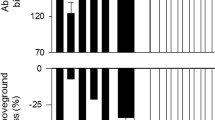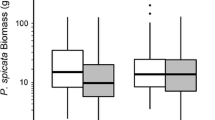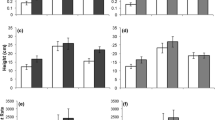Abstract
Plant invasiveness was commonly attributed to the invader’s competitive superiority over the native community, but a general pattern supporting this prediction is still lacking. This is particularly enhanced by the fact that competitive dominance and its role in plant invasiveness require the use of scarcely-practiced experimental elements. Here, we used a comprehensive experimental approach to evaluate the competitive superiority of the highly invasive annual Impatiens glandulifera. We used two competition-setting treatments, which independently examine competitive effect versus response of both native and invasive genotypes. As a neighbour species we used Urtica dioica, a vigorous perennial co-occurring with I. glandulifera at both its native and introduced ranges. By examining both components of competitive ability we were able to show that although invasive genotypes exert a weaker competitive pressure compared to their native conspecifics, they are still competitively superior to U. dioica. Our results also suggest that the high competitive ability of I. glandulifera could be attributed it to allelopathic effects on co-occurring native species. We suggest that an appropriate experimental setup, which examines competitive effect and response independently, can provide a more factual evaluation of the competitive ability of invasive plants. Furthermore, the use of a dominant species as a target plant rather than a random species or one with poor competitive ability, renders our results more general, implying that I. glandulifera might exert greater competitive effect on the less robust co-occurring species. We conclude that our approach is highly useful and advocate its application in future tests of invasion success.




Similar content being viewed by others
References
Alpert P (2006) The advantages and disadvantages of being introduced. Biol Invasions 8(7):1523–1534
Armas C, Ordiales R, Pugnaire FI (2004) Measuring plant interactions: a new comparative index. Ecology 85(10):2682–2686
Baskin CC, Baskin JM (1998) Seeds: ecology, biogeography and evolution of dormancy and germination. Academic Press, San Diego
Beaton LL, Van Zandt PA, Esselman EJ, Knight TM (2011) Comparison of the herbivore defense and competitive ability of ancestral and modern genotypes of an invasive plant, Lespedeza cuneata. Oikos 120(9):1413–1419
Beerling DJ, Perrins JM (1993) Impatiens-glandulifera royle (Impatiens-roylei walp). J Ecol 81(2):367–382
Blair AC, Wolfe LM (2004) The evolution of an invasive plant: an experimental study with Silene latifolia. Ecology 85(11):3035–3042
Blossey B, Nötzold R (1995) Evolution of increased competitive ability in invasive nonindigenous plants: a hypothesis. J Ecol 83(5):887–889
Blumenthal DM, Hufbauer RA (2007) Increased plant size in exotic populations: a common-garden test with 14 invasive species. Ecology 88(11):2758–2765
Bossdorf O, Prati D, Auge H, Schmid B (2004) Reduced competitive ability in an invasive plant. Ecol Lett 7(4):346–353
Bossdorf O, Auge H, Lafuma L, Rogers WE, Siemann E, Prati D (2005) Phenotypic and genetic differentiation between native and introduced plant populations. Oecologia 144(1):1–11
Cahill JF, Kembel SW, Gustafson DJ (2005) Differential genetic influences on competitive effect and response in Arabidopsis thaliana. J Ecol 93(5):958–967
Callaway RM, Aschehoug ET (2000) Invasive plants versus their new and old neighbors: a mechanism for exotic invasion. Science 290(5491):521–523
Dlugosch KM, Parker IM (2008) Founding events in species invasions: genetic variation, adaptive evolution, and the role of multiple introductions. Mol Ecol 17(1):431–449
Doorduin LJ, Vrieling K (2011) A review of the phytochemical support for the shifting defence hypothesis. Phytochem Rev 10(1):99–106
Dostal P (2011) Plant competitive interactions and invasiveness: searching for the effects of phylogenetic relatedness and origin on competition intensity. Am Nat 177(5):655–667
Franks SJ, Pratt PD, Dray FA, Simms EL (2008) Selection on herbivory resistance and growth rate in an invasive plant. Am Nat 171(5):678–691
Godoy O, Valladares F, Castro-Diez P (2011) Multispecies comparison reveals that invasive and native plants differ in their traits but not in their plasticity. Funct Ecol 25(6):1248–1259
Goldberg DE, Landa K (1991) Competitive effect and response: hierarchies and correlated traits in the early stages of competition. J Ecol 79(4):1013–1030
He WM, Feng YL, Ridenour WM, Thelen GC, Pollock JL, Diaconu A, Callaway RM (2009) Novel weapons and invasion: biogeographic differences in the competitive effects of Centaurea maculosa and its root exudate (±)-catechin. Oecologia 159(4):803–815
He WM, Thelen GC, Ridenour WM, Callaway RM (2010) Is there a risk to living large? Large size correlates with reduced growth when stressed for knapweed populations. Biol Invasions 12(10):3591–3598
Hejda M, Pyšek P (2006) What is the impact of Impatiens glandulifera on species diversity of invaded riparian vegetation? Biol Conserv 132(2):143–152
Inderjit, Callaway RM (2003) Experimental designs for the study of allelopathy. Plant Soil 256(1):1–11
Inderjit EvansH, Crocoll C, Bajpai D, Kaur R, Feng YL, Silva C, Carreon JT, Valiente-Banuet A, Gershenzon J, Callaway RM (2011) Volatile chemicals from leaf litter are associated with invasiveness of a neotropical weed in Asia. Ecology 92(2):316–324
Kollmann J, Bañuelos MJ (2004) Latitudinal trends in growth and phenology of the invasive alien plant Impatiens glandulifera (Balsaminaceae). Divers Distrib 10(5–6):377–385
Lankau RA, Kliebenstein DJ (2009) Competition, herbivory and genetics interact to determine the accumulation and fitness consequences of a defence metabolite. J Ecol 97(1):78–88
Lau JA, Puliafico KP, Kopshever JA, Steltzer H, Jarvis EP, Schwarzlander M, Strauss SY, Hufbauer RA (2008) Inference of allelopathy is complicated by effects of activated carbon on plant growth. New Phytol 178(2):412–423
Maron JL, Vila M, Arnason J (2004) Loss of enemy resistance among introduced populations of St. John’s Wort (Hypericum perforatum). Ecology 85:3243–3253
Moloney KA, Holzapfel C, Tielbörger K, Jeltsch F, Schurr FM (2009) Rethinking the common garden in invasion research. Perspect Plant Ecol Evol Syst 11(4):311–320
Müller-Schärer H, Schaffner U, Steinger T (2004) Evolution in invasive plants: implications for biological control. Trends Ecol Evol 19(8):417–422
Prati D, Bossdorf O (2004) Allelopathic inhibition of germination by Alliaria petiolata (Brassicaceae). Am J Bot 91(2):285–288
Pyšek P, Prach K (1995) Invasion dynamics of Impatiens glandulifera - a century of spreading reconstructed. Biol Conserv 74(1):41–48
Richards CL, Bossdorf O, Muth NZ, Gurevitch J, Pigliucci M (2006) Jack of all trades, master of some? On the role of phenotypic plasticity in plant invasions. Ecol Lett 9(8):981–993
Ridenour WM, Vivanco JM, Feng YL, Horiuchi J, Callaway RM (2008) No evidence for trade-offs: Centaurea plants from America are better competitors and defenders. Ecol Monogr 78(3):369–386
Sakai AK, Allendorf FW, Holt JS, Lodge DM, Molofsky J, Kimberly A, Baughman S, Cabin RJ, Cohen JE, Ellstrand NC, McCauley DE, O’Neil P, Parker IM, Thompson JN, Weller SG (2001) The population biology of invasive specie. Annu Rev Ecol Evol Syst 32:305–332
Scharfy D, Funk A, Venterink HO, Gusewell S (2011) Invasive forbs differ functionally from native graminoids, but are similar to native forbs. New Phytol 189(3):818–828
Schlaepfer DR, Glattli M, Fischer M, van Kleunen M (2010) A multi-species experiment in their native range indicates pre-adaptation of invasive alien plant species. New Phytol 185(4):1087–1099
Sokal RR, Rohlf FJ (1995) Biometry: the principles and practice of statistics in biological research, 3rd edn. W.H. Freeman, New York
Šrůtek M (1993) Distribution of the stands with Urtica dioica L. along the Lužnice River floodplain on the border between Austria and Czechoslovakia and land management. Vegetatio 106(1):73–87
Suding KN, LeJeune KD, Seastedt TR (2004) Competitive impacts and responses of an invasive weed: dependencies on nitrogen and phosphorus availability. Oecologia 141(3):526–535
Taylor K (2009) Biological Flora of the British Isles: Urtica dioica L. J Ecol 97(6):1436–1458
Thebaud C, Simberloff D (2001) Are plants really larger in their introduced ranges? Am Nat 157(2):231–236
Tickner DP, Angold PG, Gurnell AM, Mountford JO, Sparks T (2001) Hydrology as an influence on invasion: experimental investigations into competition between the alien Impatiens glandulifera and the native Urtica dioica in the UK. Plant invasions: species ecology and ecosystem management. Backhuys Publishers, Leiden
van Kleunen M, Weber E, Fischer M (2010) A meta-analysis of trait differences between invasive and non-invasive plant species. Ecol Lett 13(2):235–245
Vilà M, Weiner J (2004) Are invasive plant species better competitors than native plant species? evidence from pair-wise experiments. Oikos 105(2):229–238
Vilà M, Gomez A, Maron JL (2003) Are alien plants more competitive than their native conspecifics? A test using Hypericum perforatum L. Oecologia 137(2):211–215
Acknowledgments
We wish to thank Ortrun Ebinger, Mohammad Golkary, Ernst Schwärzli, Ralf Wegerer and Sinja Zieger for their technical assistance, Hana Skálová for providing Impatiens glandulifera seeds from the Czech Republic and Zafar Reshi for providing seeds from Kashmir. This study was supported by a grant of the German Research Foundation (DFG) to KT (TI338/8-1), and by the Minerva Foundation to MG.
Author information
Authors and Affiliations
Corresponding author
Rights and permissions
About this article
Cite this article
Gruntman, M., Pehl, A.K., Joshi, S. et al. Competitive dominance of the invasive plant Impatiens glandulifera: using competitive effect and response with a vigorous neighbour. Biol Invasions 16, 141–151 (2014). https://doi.org/10.1007/s10530-013-0509-9
Received:
Accepted:
Published:
Issue Date:
DOI: https://doi.org/10.1007/s10530-013-0509-9




